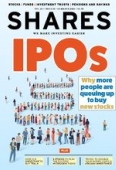Archived article
Please note that tax, investment, pension and ISA rules can change and the information and any views contained in this article may now be inaccurate.
Investors flock to value ETFs as performance soars

Exchange-traded funds (ETFs) focused on value stocks have boomed in popularity since the value rally began in November 2020, with the performance of many soaring in that timeframe.
According to Bloomberg, in the US value ETFs have already taken in $20 billion so far this year, which is already close to an annual record, and in the first week of March reportedly took in over $5 billion.
VALUE RALLY
Investors are being drawn to more beaten down stocks since the emergence of multiple Covid vaccines, as the likes of retailers, industrial firms and other cyclical stocks get set for potentially big growth in earnings compared to a low base last year as economies reopen and recover.
The rotation into value also to some degree reflects the spike in US government bond yields, a sign that markets are pricing in faster economic growth, higher inflation and the possibility of higher interest rates.

TOP PERFORMER
One of the best performing ETFs since the start of November has been State Street’s SPDR MSCI USA Small Cap Value (USSC), which according to data from FE Fundinfo has returned 61.7% since the value rally began just four and a half months ago.
Only 8.5% of the portfolio is in technology stocks, with over 50% in cyclicals (basic materials, consumer cyclicals, financial services, real estate) and another 23.8% in energy and industrial stocks.
The performance will have been helped by bricks and mortar video game retailer GameStop, the fourth largest holding in the ETF which is experiencing another big run and is still well over 10 times above the $19 a share it was trading at before investors got together on the Reddit social media platform to target certain stocks and cause them to soar.
Other holdings to have done well include retail department store chains Kohl’s and Macy’s, both of which have seen their share prices more than double since the start of November.
Despite some investor negativity towards fossil fuel firms, Texas oil companies Marathon Oil, Diamondback Energy and HollyFrontier – another three of the ETF’s top 10 holdings – have also seen their stock either double or treble in price since November.
OIL-FIRED GAINS
The oil they produce, West Texas Intermediate (WTI) crude, has risen markedly, up from $35.90 per barrel at the end of October to around $65.74 a barrel today.
Small cap stocks, or at least by American standards, i.e. those with a market cap below $2 billion, appear to be the best performing value ETF category, with SPDR MSCI Europe Small Cap Value (ZPRX) the second best performer with a 46% return in four and a half months.
Though not considered small caps over here, the ETF contains four UK stocks in its top 10 holdings – Centrica (CNA), DS Smith (SMDS), Marks & Spencer (MKS) and Royal Mail (RMG) – all of which have rallied strongly since November, with Royal Mail shares gaining more 100%.

OTHER ETF PRODUCTS
Xtrackers MSCI World Value (XDEV) and iShares Edge MSCI Europe Value (IEVL), have also done well with returns of around 38%.
Stocks in these ETFs include the likes of previously out of favour US tech giants such as Intel, Micron and AT&T, and on the European front names like Siemens, Fiat and Peugeot carmaker Stellantis and British American Tobacco (BATS).
CAN THE VALUE RALLY CONTINUE?
One question which lingers is how far the value rally can go and whether or not these ETFs and the indices they track will continue chalking up impressive returns. Despite the strong rally seen so far, the one year forward price-to-earnings ratio for SPDR MSCI USA Small Cap Value ETF is still relatively modest and stands at 15.5 times earnings, and an average price to book ratio of 1.6, while SPDR MSCI Europe Small Cap Value ETF has a forward PE of 15.1 times and a price to book of 1.1 times.
Eleanor Creagh, market strategist at Saxo Bank, is one of those who expects the rotation from ‘Covid winners’ to ‘Covid losers’ to continue.
She says consumers are ready to spend, adding that ‘Covid fatigue has set in and the pent-up demand bounce back is kicking in, further fuelling the price pressures already creeping through the system.’
She adds, ‘Disposable income has risen during the pandemic and we are looking at an aggressive demand bounce back accompanying vaccine rollout, intensified by Covid fatigue. In the US household spending expectations are at a four-year high against a backdrop of elevated savings.’
Creagh also points out that in Australia, where restrictions have been loosened much more than Europe and the US, better-than-expected fourth quarter GDP figures in 2020 were led by households spending savings built up from stimulus payments/lockdown and higher spending on discretionary items.
Important information:
These articles are provided by Shares magazine which is published by AJ Bell Media, a part of AJ Bell. Shares is not written by AJ Bell.
Shares is provided for your general information and use and is not a personal recommendation to invest. It is not intended to be relied upon by you in making or not making any investment decisions. The investments referred to in these articles will not be suitable for all investors. If in doubt please seek appropriate independent financial advice.
Investors acting on the information in these articles do so at their own risk and AJ Bell Media and its staff do not accept liability for losses suffered by investors as a result of their investment decisions.
Issue contents
Exchange-Traded Funds
Feature
- Now is a good time to take a stake in Tesla
- Hacking attacks could see surge in cyber insurance claims
- Trying to double your money using a £50,000 inheritance
- Vodafone-backed Vantage Towers: it’s all about the income
- Three IPOs to buy and the names coming soon
- Why supermarkets won’t be shaking over Amazon Fresh
- How to get involved in IPOs
- 3 stocks to play the exciting hydrogen theme

 magazine
magazine








